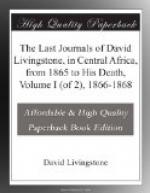3rd December, 1866.—March through a hilly country covered with dwarf forest to Kande’s village, still on the Lokuzhwa. We made some westing. The village was surrounded by a dense hedge of bamboo and a species of bushy fig that loves edges of water-bearing streams: it is not found where the moisture is not perennial. Kande is a fine tall smith; I asked him if he knew his antecedents; he said he had been bought by Babisa at Chipeta, and left at Chilunda’s, and therefore belonged to no one. Two Waiyau now volunteered to go on with us, and as they declared their masters were killed by the Mazitu, and Kande seemed to confirm them, we let them join. In general, runaway slaves are bad characters, but these two seem good men, and we want them to fill up our complement: another volunteer we employ as goatherd.
A continuous tap-tapping in the villages shows that bark cloth is being made. The bark, on being removed from the-tree, is steeped in water, or in a black muddy hole, till the outer of the two inner barks can be separated, then commences the tapping with a mallet to separate and soften the fibres. The head of this is often of ebony, with the face cut into small furrows, which, without breaking, separate and soften the fibres.
[Illustration.]
4th December, 1866.—Marched westwards, over a hilly, dwarf forest-covered country: as we advanced, trees increased in size, but no people inhabited it; we spent a miserable night at Katette, wetted by a heavy thunder-shower, which lasted a good while. Morning (5th December) muggy, clouded all over, and rolling thunder in distance. Went three hours with, for a wonder, no water, but made westing chiefly, and got on to the Lokuzhwa again: all the people are collected on it.
6th December, 1866.—Too ill to march.
7th December, 1866.—Went on, and passed Mesumbe’s village, also protected by bamboos, and came to the hill Mparawe, with a village perched on its northern base and well up its sides. The Babisa have begun to imitate the Mazitu by attacking and plundering Manganja villages. Muasi’s brother was so attacked, and now is here and eager to attack in return. In various villages we have observed miniature huts, about two feet high, very neatly thatched and plastered, here we noticed them in dozens. On inquiring, we were told that when a child or relative dies one is made, and when any pleasant food is cooked or beer brewed, a little is placed in the tiny hut for the departed soul, which is believed to enjoy it.
The Lokuzhwa is here some fifty yards wide, and running. Numerous large pitholes in the fine-grained schist in its bed show that much water has flowed in it.
8th December, 1866.—A kind of bean called “chitetta” is eaten here, it is an old acquaintance in the Bechuana country, where it is called “mositsane,” and is a mere plant; here it becomes a tree, from fifteen to twenty feet high. The root is used for tanning; the bean is pounded, and then put into a sieve of bark cloth to extract, by repeated washings, the excessively astringent matter it contains. Where the people have plenty of water, as here, it is used copiously in various processes, among Bechuanas it is scarce, and its many uses unknown: the pod becomes from fifteen to eighteen inches long, and an inch in diameter.




